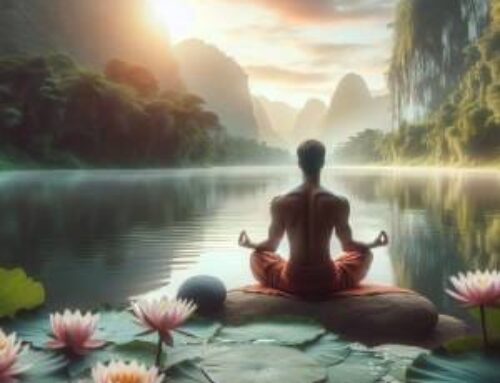Contents
- 1 Introduction to “Rituals Yoga”
- 2 Understanding the Essence: An Introduction
- 3 The Vital Energy Centers: Chakras
- 4 Reflections of Ancient Civilizations: Comparative Glimpses
- 5 Diverse Pathways: Types of Yoga and Their Rituals
- 6 Comparative Rituals: Yoga and Ancient Egypt
- 7 Conclusion
- 8 FAQ- Rituals Yoga
- 8.1 1. What are the primary types of rituals yoga and their focuses?
- 8.2 2. How do chakras play a role in rituals yoga?
- 8.3 3. What similarities exist between ancient Egyptian rituals and yoga practices?
- 8.4 4. What are mantras and yantras in rituals yoga?
- 8.5 5. Where can I learn more about yoga’s spiritual practices and rituals?
- 9 References:
Introduction to “Rituals Yoga”
Embarking on the voyage of rituals yoga, one uncovers layers beyond mere physical exercises. Yoga, a term deeply entrenched in the spiritual ethos of Hinduism and enriched by the philosophies of Buddhism and Taoism, is an all-encompassing practice aimed at uniting the body, mind, and spirit. Here, we’ll explore how rituals within yoga serve as potent instruments for spiritual growth and personal metamorphosis.

Know thyself – this is the first and greatest wisdom of all (1).
Understanding the Essence: An Introduction
Yoga is not merely about bending and stretching; it’s an intricate tapestry woven with threads of ancient spiritual traditions. The term “yoga” originates from Sanskrit, signifying “union” or “connection.” This union reflects the profound integration of various facets of the self with the divine or cosmic consciousness. Historically, yoga’s roots trace back to Hinduism, but its branches have spread, absorbing elements from Buddhism and Taoism, thus broadening its spiritual horizon and methodologies.
Rituals lie at the heart of yoga, ranging from physical postures (asanas) and breathing exercises (pranayama) to meditation and prayer. Each ritual is meticulously designed to foster spiritual elevation and personal well-being. In Hinduism, these rituals often involve chanting mantras, creating yantras, and invoking deities to aid the practitioner’s journey toward enlightenment. Far from being mere routines, these are sacred practices that elevate consciousness.
The greatest mysteries are not revealed through words, but through inner experience and deep meditation (2).
The Vital Energy Centers: Chakras
One of the intriguing aspects of rituals yoga is its focus on the body’s energy centers, known as chakras. These seven chakras are believed to be crucial points of spiritual and physical energy situated along the spine. Through specific rituals and practices, these chakras can be activated and harmonized, promoting holistic health and spiritual advancement. This highlights yoga’s profound connection between the tangible and the metaphysical realms, showcasing the depth of its ritualistic essence.
Reflections of Ancient Civilizations: Comparative Glimpses
Delving deeper, one finds fascinating parallels between rituals yoga and those of ancient civilizations like Egypt. Both cultures placed immense emphasis on rituals as gateways to spiritual connectivity and transformation. In ancient Egypt, rituals involving postures and symbolic gestures served purposes akin to yoga postures, aiming to bridge the human with the divine and cosmic order.
Diverse Pathways: Types of Yoga and Their Rituals
Yoga presents a myriad of paths, each with distinct rituals tailored to specific spiritual and physical aspirations.
Hatha Yoga
Possibly the most renowned form in the West, Hatha yoga emphasizes physical postures, breathing techniques, and relaxation. Its rituals are crafted to cleanse the body, dispel blockages, and liberate life energy (prana). This practice stresses the balance of opposites and the unity of body and mind, paving the way for deeper meditation and spiritual practices.
Bhakti Yoga
Bhakti yoga revolves around love and devotion to the Divine. Its rituals include singing hymns (kirtan), chanting mantras, and participating in worship (puja). These practices aim to nurture a loving bond with the divine, dissolving the ego to achieve spiritual unity. Bhakti yoga is a heart-centered path where emotional and spiritual energies converge harmoniously.
Jnana and Karma Yoga
Jnana yoga champions the path of wisdom and knowledge, with rituals involving intense scriptural study, meditation, and reflective practices to comprehend reality and the self. Conversely, Karma yoga is the path of selfless action and service. Its rituals entail performing altruistic deeds without attachment to outcomes, reinforcing the concept that selfless work itself can be a profound spiritual practice.
In the grand tapestry of yoga, rituals are not mere embellishments but are foundational elements that intertwine physical, mental, and spiritual realms, guiding practitioners toward a state of holistic well-being and profound enlightenment.
When one delves into the world of chakras and rituals yoga, they unearth a fascinating landscape of energy centers, ancient practices, and spiritual enlightenment. Chakras, integral to many rituals yoga, represent pivotal points of energy that deeply influence physical, mental, and spiritual well-being.
Understanding Chakras
Picture seven major chakras aligned along your spine. Each one is a whirlpool of energy associated with specific colors, elements, and spiritual qualities. From the root chakra at the base of your spine—anchoring you to survival instincts—to the crown chakra at your head’s summit, symbolizing spiritual enlightenment, these energy centers form a vital framework in yoga practices.
Activating Chakras
Rituals yoga often incorporate various techniques to awaken and balance these chakras. Specific postures, breath control, and meditation focus intently on each chakra, promoting an unhindered flow of energy and eliminating blockages. This harmonization is believed to not only enhance overall health but also fuel spiritual growth.
Mantras & Yantras
Let’s sprinkle in a bit of sacredness with mantras and yantras. Mantras, the revered sounds, and yantras, the intricate geometric designs, play indispensable roles in chakra rituals. Each chakra has its dedicated mantras and yantras, aiding in its activation and balance. Imagine chanting these sacred sounds or meditating on the beautiful yantras during your yoga practice. It’s a profound way to deepen your connection to the spiritual essence of each chakra, fostering a holistic sense of well-being.
Comparative Rituals: Yoga and Ancient Egypt
The spiritual realms of yoga and ancient Egypt bear striking similarities, especially in their ritualistic practices. Both traditions utilize postures and symbolic gestures aimed at divine connection.
In ancient Egyptian rituals, practitioners engaged in postures and gestures, known as “god forms,” to embody deities’ qualities, much like the asanas in yoga. These postures were not merely physical exercises but acts of aligning with cosmic principles.
Symbolic gestures also bridge these traditions. Mudras, the hand gestures in yoga, channel energy and enhance meditation, akin to the gestures in Egyptian rituals believed to invoke divine presence and protection.
Both cultures also acknowledged energy centers within the body. While rituals yoga focuses on chakras, ancient Egyptians understood sacred metals and planetary influences corresponding to body’s energy centers. This shared belief underscores the interconnectedness of physical and spiritual realms.
The Guru’s Role
In the Eastern tradition of yoga, gurus are more than teachers; they are spiritual guides. These enlightened souls possess profound knowledge and experience, offering personalized instruction and mentorship. The guru-disciple relationship is foundational, emphasizing the direct transmission of wisdom and spiritual energy.
Yet, this tradition sometimes clashes with Western values of individualism and self-reliance. Western spiritual traditions, such as Hermeticism, also offer rich paths to spiritual development. They emphasize esoteric knowledge, personal transformation, and mystical experiences, complementing the Western ethos.
Rituals yoga’s teachings are invaluable, but exploring Western spiritual traditions can lead to a more balanced and holistic spiritual journey. Integrating these diverse practices can enhance one’s spiritual growth, providing a richer tapestry of understanding.
Conclusion
Rituals yoga are powerful tools for transformation. By understanding and practicing these rituals, one can achieve harmony between body, mind, and spirit. Exploring various yoga forms, the role of chakras, and the intriguing parallels with ancient Egyptian practices highlights the universal quest for spiritual growth and enlightenment. For deeper insights, engaging with the western teachings at the Hermetic Academy offers a profound opportunity to expand one’s spiritual horizons (3).
FAQ- Rituals Yoga
1. What are the primary types of rituals yoga and their focuses?
A: The primary types of rituals yoga include Hatha yoga (physical postures and breath control); Bhakti yoga (devotion to the divine); Jnana yoga (knowledge and wisdom); and Karma yoga (selfless action and service).
2. How do chakras play a role in rituals yoga?
A: Chakras influence physical, mental, and spiritual well-being. Rituals yoga aim to activate and balance chakras, enhancing overall health.
3. What similarities exist between ancient Egyptian rituals and yoga practices?
A: Both traditions use postures, symbolic gestures, and energy centers to connect with divine energies and foster spiritual growth.
4. What are mantras and yantras in rituals yoga?
A: Mantras are sacred sounds used in meditation to focus the mind. Yantras are geometric designs aiding meditation and symbolizing divine aspects.
5. Where can I learn more about yoga’s spiritual practices and rituals?
A: For in-depth understanding and structured training, the Hermetic Academy offers resources on various spiritual western practices, to help individuals achieve holistic well-being and spiritual enlightenment.
References:
(1) Eckartshausen, Karl von. (1802). Die Wolke über dem Heiligtum. München.
(2) Eckartshausen, Karl von. (1802). Die Wolke über dem Heiligtum. München.
(3) Rubenstein, E. (2024) The Hermetic Experience: From Mystery to Self-Knowledge. Hermetic World, Paphos.





